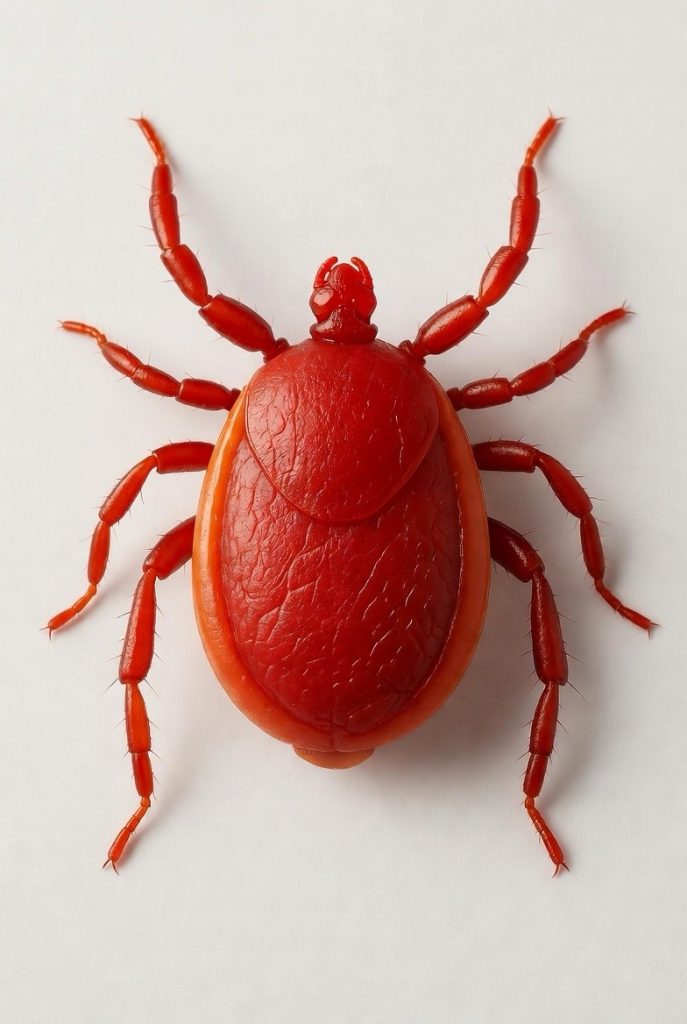Alpha-gal syndrome (AGS) is a tick-borne meat allergy caused by the Lone Star tick (Amblyomma americanum) injecting alpha-gal sugar into the blood, triggering IgE-mediated reactions to red meat like beef, pork, and lamb. Symptoms—hives, itching, swelling, nausea, or anaphylaxis—appear 2–6 hours after eating, often mimicking IBS. Not everyone develops it; risk rises with repeated bites, genetics, and non-B/AB blood types. Diagnosis uses blood tests for alpha-gal IgE; skin tests fail. No cure exists—avoid red meat, dairy, gelatin, and mammalian meds (e.g., heparin, cetuximab). Carry epinephrine. Prevent with tick checks, DEET, and permethrin clothing. Cases are rising globally, especially in the U.S. South. Some improve if bites stop. Patients report delayed diagnosis, strict diets, and life-changing restrictions, but many adapt well.
Long Version
Understanding Alpha-Gal Syndrome: A Tick-Borne Meat Allergy
Alpha-gal syndrome (AGS), also known as mammalian meat allergy (MMA), represents a unique and increasingly recognized food allergy triggered by tick bites. First identified in the United States in the late 2000s, this tick-borne condition arises when a tick injects the sugar molecule galactose-alpha-1,3-galactose—commonly called alpha-gal—into the bloodstream via its saliva. This prompts an aberrant immune response, leading to allergic reactions upon consuming red meat like beef, pork, or lamb. Unlike typical allergies, AGS features a delayed reaction, often manifesting hours after exposure, which complicates diagnosis and management. Not everyone bitten by a tick develops this syndrome; factors such as genetics, individual immune response variations, and repeated bites heighten susceptibility. While the condition can fade over time with strict avoidance of further tick encounters, it demands lifelong vigilance for many.
Causes and Transmission
The primary culprit behind AGS is the Lone Star tick, scientifically named Amblyomma americanum, prevalent in the southeastern and eastern United States. This tick carries alpha-gal in its saliva, transferring it during a bite and reprogramming the body’s immune system to view the molecule as a threat. Other ticks worldwide contribute similarly, including the European castor bean tick (Ixodes ricinus) in parts of Europe, the paralysis tick (Ixodes holocyclus) in Australia, and species like Haemaphysalis longicornis in Asia or potentially Amblyomma hebraeum in South Africa. Research confirms that only certain individuals develop the allergy post-bite, with unknown components in tick saliva likely playing a pivotal role. Notably, alpha-gal is absent in humans and some primates but present in most mammals, explaining why red meat—rich in this sugar—triggers reactions after sensitization.
Emerging evidence highlights geographic expansions, with cases reported in unexpected areas like Hawaii and the western U.S., suggesting involvement of unidentified tick species. Cases have documented rapid onset following a tick bite, underscoring the condition’s potential for swift development.
Symptoms and Clinical Presentation
AGS symptoms typically emerge 2 to 6 hours after ingesting alpha-gal-containing foods, marking it as a delayed anaphylaxis scenario distinct from immediate food allergies. Common manifestations include urticaria (hives), pruritus (itching), and swelling of the face, lips, or throat. Gastrointestinal symptoms such as stomach pain, nausea, vomiting, or diarrhea often accompany these, sometimes mimicking irritable bowel syndrome (IBS) and leading to misdiagnosis. More severe cases involve respiratory distress, wheezing, dizziness, a rapid drop in blood pressure, or full-blown anaphylaxis, which affects about 60% of patients and can be life-threatening, especially in those with asthma.
Not all exposures provoke reactions; factors like alcohol consumption, exercise, or the quantity of alpha-gal ingested influence severity. Intriguingly, some patients experience isolated gastrointestinal symptoms without skin involvement, further delaying recognition. Blood type may modulate risk—those without B or AB antigens face higher susceptibility, as these resemble alpha-gal and offer partial protection.
The Immune Response Mechanism
At its core, AGS is an IgE-mediated allergy, where the immune system produces excessive IgE antibodies against alpha-gal following tick bite exposure. Upon subsequent ingestion of red meat or mammalian products, these antibodies trigger mast cells to release histamines and other mediators, culminating in the allergic cascade. This delayed reaction stems from the time needed for alpha-gal to be digested and enter the bloodstream, differentiating it from protein-based food allergies.
Diagnosis
Diagnosing AGS requires a detailed history of tick bites and delayed symptoms post-meat consumption, coupled with a blood test measuring IgE antibodies specific to alpha-gal. Skin-prick tests are unreliable, often yielding false negatives, while advanced options like basophil activation tests with cetuximab are more sensitive but costly. Guidelines urge suspicion in cases of unexplained abdominal pain or gastrointestinal symptoms sans classic allergy signs. On average, U.S. patients endure over seven years from symptom onset to diagnosis, highlighting systemic gaps.
Treatment and Management
No cure exists for AGS; management centers on avoidance of triggers. Patients must eliminate red meat, offal, and sometimes dairy, gelatin, or glycerin in medications and vaccines, as these can cross-react. For acute reactions, over-the-counter antihistamines suffice for mild cases, but anaphylaxis demands immediate epinephrine via autoinjector, followed by emergency care. Emerging desensitization protocols show promise but remain experimental.
Medications pose risks; over 50% of patients react systemically to mammalian-derived excipients like gelatin or glycerin in drugs such as cetuximab or certain NSAIDs. Surgical considerations include avoiding porcine-derived products like heart valves or heparin. Tools aid in identifying safe options, and consulting allergists is essential.
Prevention Strategies
Preventing AGS hinges on evading tick bites. Use permethrin-treated clothing, DEET repellents (20%+ concentration), and stick to trails in tick-prone areas. Post-outdoor checks, showers, and high-heat drying of clothes kill unattached ticks. Remove attached ticks promptly with tweezers, grasping near the head to avoid crushing. Avoiding further bites allows IgE levels to decline, potentially resolving the allergy over time.
Epidemiology and Risk Factors
AGS has surged globally, reported in 17 countries across six continents, with Australia boasting the highest rates of mammalian meat allergy. In the U.S., cases climbed from 13,371 in 2017 to 18,885 in 2021, concentrated in southern and central regions aligning with Lone Star tick distribution. States like Arkansas, Kentucky, Virginia, and West Virginia now mandate reporting. Risk escalates in tick-endemic areas, with repeated bites amplifying chances; genetics and blood type also influence vulnerability.
Patient Stories and Personal Experiences
To illustrate the real-world impact of alpha-gal syndrome, consider these anonymized accounts from individuals living with the condition, highlighting the challenges in diagnosis, daily management, and emotional toll.
One person, a fit and healthy 28-year-old, experienced a dramatic life change after developing AGS from tick bites. Previously active and enjoying a varied diet, they suddenly faced severe reactions to red meat, including hives, swelling, and gastrointestinal distress hours after meals. Misdiagnosed initially with food poisoning or IBS, it took multiple emergency visits before a blood test confirmed alpha-gal sensitivity. Now, they adhere to a strict plant-based diet, avoiding even trace mammalian products in medications, and carry epinephrine at all times. The adjustment has been isolating, but connecting with support networks has helped them adapt.
Another individual, bitten by ticks during a hike, developed symptoms that baffled doctors for years. They described waking up in the middle of the night with intense itching, nausea, and difficulty breathing after eating beef or pork. Medical professionals dismissed early complaints, suggesting stress or unrelated allergies, leading to unnecessary tests and treatments that worsened their condition. Finally diagnosed after persistent advocacy, they now manage frequent anaphylactic episodes with careful meal planning and avoidance, but express frustration over the lack of awareness in healthcare, noting they’ve gone days without solid food during flares.
A professor shared their journey after living with AGS for over two years, triggered by tick bites. Symptoms began subtly with delayed reactions to meat, escalating to full anaphylaxis. As someone in academia, they highlighted the importance of raising awareness, detailing how everyday items like gelatin in vaccines or dairy in coffee became hazards. Through trial and error, they’ve learned to navigate social situations, like declining barbecues, and emphasize that while the allergy can fade with bite avoidance, vigilance is key.
In a lighter case, someone reported mild reactions to meat and dairy after Lone Star tick bites, affecting gelatin products like jello or gel-cap medications. They’ve managed by switching to alternatives and monitoring symptoms closely, but note the syndrome’s restrictive nature on diet and lifestyle.
A couple dealing with AGS for four years described it as a tough, preparation-heavy existence. Both sensitized by ticks, they’ve overhauled their routines, prepping meals meticulously and avoiding cross-contamination. While challenging, they’ve found ways to thrive, focusing on non-mammalian proteins and sharing tips with others.
One story involved airborne reactions: While near cooking meat, the person became dizzy, fatigued, and passed out, only to be woken by their dog. This underscores that triggers aren’t limited to ingestion; fumes from grilling can provoke symptoms in sensitive cases.
Finally, a patient who once enjoyed outdoor activities now limits exposure to prevent re-sensitization. After initial severe anaphylaxis from pork, they’ve seen improvement over time without new bites, offering hope that remission is possible. However, they caution that alcohol or exercise can still amplify reactions, requiring ongoing caution.
These stories reveal common themes: delayed diagnosis due to unfamiliarity, profound dietary shifts, potential for remission, and the need for better medical education on AGS.
Recent Research and Insights as of 2025
Research reveals overlooked cardiac implications, with AGS potentially exacerbating heart conditions due to anaphylactic stress. Surveillance in various regions and rising diagnoses signal an alarming growth. Pre-clinical models and emerging technologies aim to bridge knowledge gaps, while proposals have suggested leveraging AGS to influence dietary habits for broader benefits. Public awareness campaigns emphasize the tick-borne link, highlighting personal stories and rapid regional increases. Ongoing studies focus on desensitization and improved diagnostics to transform AGS from a hidden threat into a manageable condition.

Hashtags For Social Media
#alphagalsyndrome #alphagalallergy #tickborneillness #meatallergy #lifestyletips #healthawareness #foodallergy #allergylife #tickbiteawareness #chronicillness #autoimmunedisease #allergycommunity #glutenfree #dairyfree #redmeatallergy #alphagalwarrior #allergyfriendly #invisibleillness #wellnessjourney #allergyawareness #healthiswealth #medicalmystery #holistichealth #alphagalrecovery #lifestylechange #tickprevention #naturalhealing #healthyliving #epipenready #stayprotected
Related Questions, Words, Phrases
what is alpha-gal syndrome | how does alpha-gal syndrome cause meat allergy | can tick bites really make you allergic to meat | what are symptoms of alpha-gal allergy | how long after eating does alpha-gal reaction occur | what foods should you avoid with alpha-gal | is alpha-gal syndrome permanent | can alpha-gal go away over time | what causes alpha-gal allergy | how to test for alpha-gal syndrome | can you eat chicken or fish with alpha-gal | what is the connection between lone star ticks and meat allergy | how common is alpha-gal syndrome in the us | what are the first signs of alpha-gal syndrome | how to prevent alpha-gal syndrome | can alpha-gal cause anaphylaxis | does alpha-gal allergy affect dairy products | what medications contain alpha-gal | how do you manage alpha-gal syndrome | can you live a normal life with alpha-gal | why do alpha-gal symptoms appear hours later | how is alpha-gal different from other food allergies | what blood test detects alpha-gal antibodies | can you have alpha-gal and not know it | how to treat alpha-gal allergic reaction | is there a cure for alpha-gal syndrome | what states have the most alpha-gal cases | how fast can alpha-gal develop after a tick bite | can pets give you alpha-gal syndrome | does alpha-gal allergy cause stomach pain | what are hidden sources of alpha-gal in foods | can alpha-gal patients eat gelatin | how to protect yourself from lone star ticks | can alpha-gal come back after remission | what to do if you suspect alpha-gal syndrome






